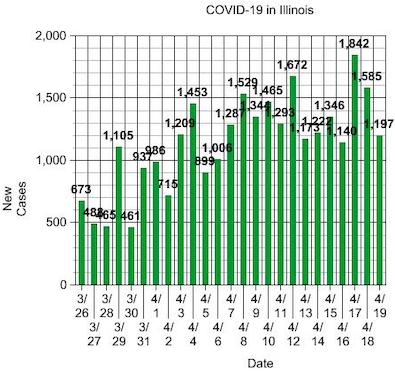* Gov. Pritzker extended a welcome home to a National Guard unit…
I pleased today to welcome home from overseas the first battalion of the 178th Infantry Regiment of the Illinois National Guard under the command of Lieutenant Colonel Matthew Garrison. 400 of our most exemplary Illinoisans served in Afghanistan to advance operation freedoms Sentinel.
These are remarkable individuals who possess a phenomenal strength. And as soldiers of the 178 infantry also carry the legacy of having descended from the nation’s first all black National Guard unit, the fighting eighth.
As governor, I have the honor of serving as the commander in chief of Illinois citizen soldiers. And in my first 16 months, I’ve learned a thing or two about the 13,000 women and men who make up the Illinois National Guard. Namely, they’re an astonishingly humble group, even though they’ve earned the right to take extraordinary pride in what they do.
In the midst of this COVID-19 emergency, I hope you’ve had a chance to see as I have just how amazing the Illinois National Guard is. Because it’s the guard that’s setting up our drive through testing sites to serve our first responders, our medical professionals and everyday resonance. It’s the guard that has helped to build the alternate care facility at McCormick Place at a jaw dropping record pace. It’s the guard that has provided critical surge support, as we’ve managed outbreaks in our facilities. It’s the guard who deserves our deepest reverence and gratitude.
* PPE…
I also want to share more positive news on the peopIe front we have another airlift of PPE arriving tomorrow in Illinois, that follows our first flight that landed earlier this week.
I’ll note that it’s the Illinois National Guard handling transportation logistics on the ground and ensuring that our protective equipment gets to the frontlines in the COVID-19 battle.
These millions of masks and gloves and other PPE will be taken to our state warehouse where inventory and performance quality checks are done before we ship them out to keep our first responders and our healthcare professionals protected as they work to keep us safe.
If it strikes you as a typical that in the midst of a national emergency a state is directly airlifting emergency response materials from another country, well, you’d be right. But that’s the landscape that we’re operating in, competing with other states, other countries, and even our own federal government for supplies. So if an airlift is what it takes to bring the PP to protect our nurses or firefighters or police officers and other essential workers, then it’s an airlift that we’ll use without hesitation.
* On to questions for the governor. I missed the first question because the video feed conked out, but the answer suggested the question was basically the same as usual. When is the state reopening? The answer was the same.
* President Trump is talking of course about opening the country possibly in stages, and there are parents out there today who have giant concerns wondering if their company says they’re one of the people who have to stop working from home and have to stop start going back into their businesses, while their kids are still home. Can you answer what Illinois might be able to provide to those parents?…
In terms of childcare for example we’ve created emergency childcare. In fact, all across the state that’s something we did weeks and weeks ago because of the essential workers and their needs. And there is capacity out there and we of course want to encourage people to become emergency childcare providers.
So to the extent people will go back to work and their kids will be at home. During the school year, that is one option for people, of course during the summer, people who normally work and their kids would be not in school during the summer. They’ll have that same problem if the kids were otherwise going to go to some congregate setting day camp or something else.
* There are people who are still going into their places of employment obviously such as nursing homes and things, and many of these businesses they are doing their due diligence they’re checking temperatures right at the door. But is that enough given the fact that COVID-19 can be asymptomatic for so long?…
The answer is no, it’s not enough, and what we really need is rapid testing in all of those settings, the ones that you’re describing congregate settings, but also everywhere else.
What we really would like is for people to be able to get tested on a very regular basis until we have a treatment and a vaccine. You want to know that people who are coming to work with you are not COVID positive. The challenge I think as you are well aware is that for weeks and weeks now, a couple of months that have gone by, the understanding by the scientists and the doctors has evolved because they’ve come to see for example what you’re describing people can be asymptomatic and pass along COVID-19. That wasn’t something that the CDC, for example, or the federal government or anybody really was saying, a month and a half ago.
And so as we learn more, you know, the evolution of how we think about how to get back to work, changes but you’re raising an excellent point. We need more than just a temperature check at the door right now that’s the only thing that we really have doing a wellness check for workers that walk in and doing a temperature check which is, you know, takes a moment to do.
* Hi governor. Will Jones from ABC. I have two questions. The first one is for you. And then the second one is for Dr. Ezike. The first question is, what can you tell people who are anxious about when this is going to be over?…
The first thing I would say is that we’re frankly I think everybody is anxious because we don’t know so much right, there’s a lot that still needs to be learned here, and we don’t have the treatment or the vaccine to really deal with this in a way that will make people feel safer.
But, as we’re learning more and sharing information all across the country and as the CDC provides more information as our Department of Public Health does its work. I think we’re, you know we’re getting a greater understanding day by day, and people should feel I think somewhat more confident today than they did weeks ago.
And let me give you one example of why I think I may have mentioned this in the last couple of days. But the report out of Chicago hospital was the University of Chicago, that the trials on remdesivir are one of the 70 different treatments that are in trials right now that the reports are very positive. Now, that doesn’t mean that the study is completed and that this is an approved treatment. But the idea that there’s something that’s gotten positive results, and that at least is rumored to be one of the main treatments that may be available. I think that is some really great news right that’s something to add on to as we see the bending of the curve here in the state, if you can have a treatment. Right. And then you see the beginning of decline of cases and a decline of hospitalizations, having a treatment makes an enormous difference. So people should start to feel more confident, seeing that are amazing private sector researchers, and that’s really what’s happening. Many of these private companies, the pharmaceutical companies as well as our NIH, scientists, that collectively, the United States is the greatest country in the world and, indeed, because we are so innovative and in the face of this pandemic the idea that we’re 70 treatments are in trials and a few of them look like they might be effective in just a couple of months that’s pretty amazing.
* Hi. Amy Jacobson WIND Chicago. I have a question for you and a question for the doctor. While I won’t hog the mic [ha!]. … The PPE that’s landing tomorrow. Where’s it coming from and what do you want to say to the FBI agent here in Chicago who stopped your procurement team from wasting $26 million of our tax dollars? [That’s two questions] Because there’s a lot of scams going on, not just in Illinois all over the country, and they were about to purchase $26 million for pay a company that money, and it was a big company…
It’s coming from China … You should know that most of the PPE that is manufactured in the world, and again, we’re talking about disposable PPE, not the fabric masks and other things which are much more expensive but the disposable PPE which is needed by healthcare workers and first responders, that comes from China and so this is coming from China. I don’t recall right now where this particular shipment is coming from exactly in China.
As to scams. Oh my goodness, I mean I’ve talked to other governors, yeah you as you can, as you can imagine you’ve seen it all online if anybody’s even looked up for any PPE on their own. And you know the scams are everywhere you can imagine, you know, big ones and small ones right and people have tried to contact us to get us signed up for you know delivery of PPE that doesn’t exist. And we’ve had to ferret those things out and we’ve definitely been working with law enforcement, also with the attorney general, I think I mentioned that yesterday that you know we need our attorney general on it but if you’re talking about an international seller, but you know we don’t. We’re not allowed in the state of Illinois to purchase directly from any international provider. And so we use either an Illinois company or a US company to go find that for us and so sometimes in that process. You know, there can be people you know bad actors and we definitely rely upon the FBI, and our state police and our Attorney General to help ferret those things out for us.
* Amy Jacobson at WIND: Thank you. Doctor, I have one quick question. First of all thank you for all that you’ve done and your dedication to this. I think it would be helpful for all of us, Illinois, if we knew because every day we come out with numbers, how many of those are active cases. How many are in ICU. How many have recovered because I think that would help, maybe some people sleep better at night because I know we’re gonna have larger numbers because more people are being tested, right [Most of those answers are online, so she hogged the mic for nothing again and now let’s move along.]
* CBS 2: Vice President Pence says 5 million tests should be completed by the end of the month. He calls that a success. Nancy Pelosi was on fox news this morning she gives President Trump an F when it comes to testing. So who’s right and where do we stand in Illinois right now?…
Well let me respond to the question about testing. I’ve been frustrated when I hear the White House talk about testing capacity, versus testing they seem to use those interchangeably. Those are very different. Testing capacity is the capability, machines that exist in your state that could possibly run a test.
But as you know, well, because I’ve talked about it a lot over the last month and a half, that you need a lot of other things in order to actually have a test result. You need a swab to take the specimen, you need the viral transport medium to put the specimen in so that it can be transported safely. You need the RNA extractor, so that the process can run properly and you need the machine, and oh by the way you need lab technicians and a lot of them because we’re doing a lot more testing than normally gets done. Because we have this novel Corona virus that we have to test for.
So when you think about testing capacity, you know they say well we have the ability to do X number of tests. Well yeah, testing capacity is large, but if you don’t have all of those items, which, by the way, none of the states have all of those items that they need. You actually use the testing capacity that’s available, so very frustrating.
Look today where are we, what you saw today we announced, you know 6000 specimens were announced today that were tested, and you saw that 1100 and some positives among the 6000. We have a fluctuating number, every day it’s going to be different. Each day, because you get different reports each day I’ll tell you today. We got no report from one of the largest commercial laboratories in the country. And so that’s that’s a number of tests that were obviously done and completed, but never reported to us because they didn’t report it to anyone in the country. You know what, why that is. I can’t tell you but we’ll get those tests tomorrow and hopefully we’ll get all of the tests that were done yesterday reported tomorrow and test today reported tomorrow but we’re a little bit at the whim of these commercial laboratories. Now we control our own state laboratories which are doing amazing jobs. And then we have terrific hospitals here in the state that are doing a lot of testing as well.
* I spoke with Dr. Howard Herman from UIC right before I came here. He said the problem with a lot of what you’ve done is that you’ve made the procedures and the policies optional, he said for example masks. Why not order the use of masks?…
I appreciate that, and he’s right. I didn’t order it. And I have considered doing that and still I’m considering doing that.
As you know, I came out strongly and told people that they should be wearing masks and every time I talk about this, wash your hands, wipe your surfaces, make sure you’re wearing a mask when you go outside. But have I put an order in yet? No, but you’re foreshadowing that.
I mentioned this also a few days ago that one of the Republican state representatives Rep. Batinick has been very helpful providing ideas. And that is one idea that he suggested. His suggestion was just for a retail establishment like grocery stores and the essential workers all wearing them, and people who go to those locations as well. That’s a good first step, for example.
But I don’t disagree with the comments of the doctor, you know it may be that the right answer is everybody wears a mask, no matter where they are outside, or perhaps everybody wears a mask if they know that they’re going to be in an area with other people.
* If you do decide to do that [mask] order, when might that happen?…
April 30 is when our stay at home order expires. And so we’re looking at how we might make adjustments. And so, obviously between now and then, we’ll be making some decisions about that and putting that forward.
* The Lupus Society of Illinois has a petition asking you to prohibit doctors from preemptively prescribing hydroxychloroquine as COVID prevention as it’s causing a shortage of the drugs. Will you do that why or why not?…
There’s been a lot of discussion about hydroxychloroquine by the president, he’s pushed it a lot. And then it therefore is being overused without a lot of testing to back it up. The decision by doctors about whether to use something that’s off brand, you know something that’s allowed and permitted it’s an FDA approved drugs, and then using an off brand, those are decisions that are typically made by doctors. … I don’t disagree that it shouldn’t be used off brand unless you really know that it works and right now we just don’t know that it works.
* Me: This is mainly a federal issue, but with so many meat processing plants shutting down or experiencing spikes in cases, is there a state role in improving these conditions?…
Indeed, the federal government of course regulates those plants. But it is also the responsibility of the state to keep the people who work there, who live in our state of course, safe and of course the businesses in our state as well.
So, we have worked with local health departments on making sure that they are using PPE in those facilities, and making sure that the people who work in this facility are safe and not forced to work if they are not feeling well, if they have any symptoms at all. And some plants are very good about following all of those, and some, we’ve had to talk to, have discussions with, and you know have have been threatened to force closure.
* Dahl: You have gotten attention nationally during this pandemic. How does the State benefit and how do you benefit from this heightened profile?…
The most important thing that’s happened is we’ve actually gotten more from the federal government as a result of by, you know, having a slightly higher profile or speaking out nationally.
I’m very pleased with what we’ve received from the army the Army Corps of Engineers, FEMA, HHS and I continue to have dialogue, behind the scenes. It’s not just speaking out publicly, behind the scenes speaking with the vice president directly, but also White House advisors, speaking to representatives of the various departments, including the Secretary of Defense, the Secretary of the Army, the Secretary of HHS directly about our needs, so that we can get them fulfilled. … But, you know, you’ve heard me publicly talk about some of the things that the White House has promised and hasn’t been able to deliver. But ‘ll continue to do whatever I have to do to make sure that we get what we need in the state of Illinois.
* How can mass testing be a pillar of our recovery recovery plan when the centers for infectious disease research and policy says there won’t be enough reagent needed to conduct those tests?…
Well this is I think a great example of the challenge of not having invoked the defense production act. If we had done that, if we had gotten you know the chemical companies and the companies who produce reagent to essentially focus all of their resources on delivering for the states, we could have been further along. But I think all the companies that produce reagent, not to mention all the other items that I mentioned that are part of the supply chain, all of those items are in short supply. And all of those items I’m fighting hard for.
I will say I’m very pleased that we’ve been able to do more than some other states recently in order to have all the supplies to ramp up our testing. And then we need to actually ramp it up with using all of those pieces of the supply chain together.
* Politico: What would you recommend to Senators Durbin and Duckworth and Representative Davis who are on the President’s task force to open the economy, what to address first?…
Well, I mean I’m partial to the industries that are particularly important here in the state of Illinois.
One thing I think has been very challenging for people is, how are we protecting, and this is very important, how are we protecting the workers and the customers in each of the retail and wholesale and warehouse situations.
We’re the supply chain hub of the nation here in Illinois. We have a lot of warehouses and distribution. Not to mention manufacturing and other things but how do we protect the workers, and the customers, and give guidance more than just you know six feet apart, and maska by industry, I’m working on this myself. But, this is a problem that every state that is similar to ours or every industry, like the industries that we have here in Illinois, is trying to grapple with, so I hope that they will address that.
* Rock River Times: Now that we’re seeing more grocery store workers infected with COVID-19, shoppers are worried that they will be infected by touching items they purchase, and should shoppers wipe down items that they buy at stores?…
They absolutely should wipe down items that they buy at the stores.
I would suggest to everybody there are a couple of very good and well thought out demonstration videos and articles about what you should do when you go to the grocery store. When you buy things, you bring them home how you should handle that, when you get home, everything really needs to be wiped down. And whatever it is you’re carrying the groceries in needs to immediately be thrown away or, you know, if it can be wiped down, great, but you need to get it out of your kitchen and make sure that it’s out of the reach of anybody who would touch it and, therefore, possibly be infected by something that’s remaining on those items. But it can be done. And again there are lots of good instructional videos and articles about that.
-30-















